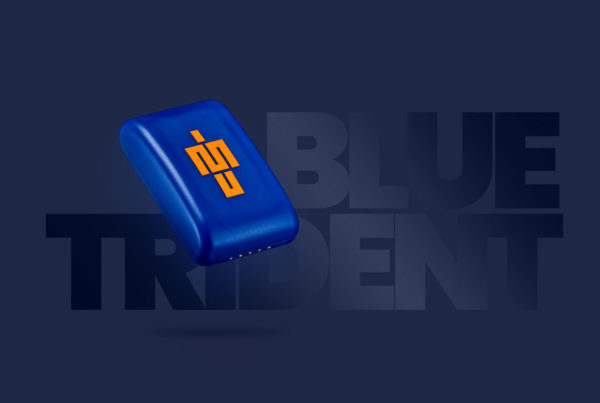By Joe Lemire. Source: SportTechie
How much force a leg exerts when kicking a soccer ball would seem to be a straightforward question that could be easily answered in today’s tech-laden world, but collecting that data has been complicated by the lack of adequate sensors in the marketplace.
Standard accelerometers max out at a force of 16 g, says Vicon life sciences product manager Kim Duffy, and that doesn’t even begin to gauge the full power of an adult’s kick.
The sensor, she says, “basically flat-lines.”
The soon-to-be-released Blue Trident sensor can measure forces up to 200g. (Premier League photo by Stu Forster/Getty Images :: Blue Trident courtesy photo :: SportTechie Photo Illustration) n Kee / ESPN Images).
Finding a way to solving this problem went into the development of Blue Trident, the first inertial sensor released by Vicon since its acquisition of IMeasureU in 2017. Blue Trident includes both a low-g sensor and a high-g sensor, allowing it to capture forces up to 200 g (a limit that far exceeds the 100 g kicks registered in the Australian Football League, for instance).
Blue Trident debuted in June at an exhibition hosted by the National Athletic Trainers Association and will be released to the public in August. The device is IP68 rated for water submersion up to three meters for an hour, which permits use on underwater treadmills.
The wearable is compatible with three software platforms: Capture.U, a mobile app showing real-time data overlaid on video; IMU Step, a lower-limb monitoring tool; and Nexus 2.10, a platform that integrates inertial data with optical motion capture. Currently compatible with iOS 10x, Capture.U, is the wholly new app and optimized for use in more practical sports environments as opposed to lab settings.
“This is all about mobile collection,” says Duffy, adding: “The emphasis is all about real-time and being able to have real-time IMU data on top of video analysis, which is obviously really powerful.”

“This is all about mobile collection,” says Duffy, adding: “The emphasis is all about real-time and being able to have real-time IMU data on top of video analysis, which is obviously really powerful.”
IMU Step remains a helpful aid for trainers in developing return-to-play protocols for athletes. The sensor can track cumulative bone load and detect asymmetries. It’s popular in basketball and even used by the NBA’s Philadelphia 76ers.
“Most wearable tracking technology is designed to address general use cases and is typically a single unit worn on the centre of mass or wrist,” says Matt Clarke, director of business development, IMeasureU. “Our approach with IMU Step is precise and specific. Subjects wear a high-fidelity, synchronized sensor on each ankle—the source of the running load—to accurately quantify the intensity of every step they take, whether they’re a professional player in rehab from an injury or a school track team looking to improve their times.”




